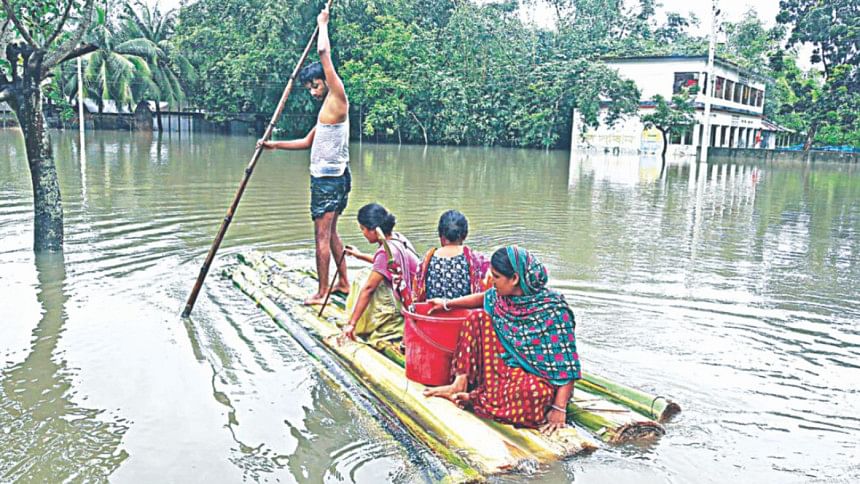Disaster preparedness: A shift in paradigm

Since the late-20th-century, a shift in paradigm has happened in the intellectual arena of architecture, art, literature, philosophy, history, economics, fiction, etc. It happened mostly in the industrialised countries and emerged as Postmodernism, a critique of "modernism". Terminologies such as "deconstruction" and "post-structuralism" have also gained popularity in twentieth-century thoughts.
"Economic growth is not necessarily good" or the notion of sustainable development ("Our Common Future", 1987) urging for "meeting the needs of the poor, without compromising with the ability to meet the needs of future generation" directed a rethink of the ways in which economic growth are generated. The shift in paradigm (from human exceptionalism) was also connected to ecological disruptions in many parts of the world.
People in industrial societies identified changes in air and water qualities and expressed certain environmental concerns. Voices were also raised by affected women and men in non-industrialised countries (ecofeminism and post-modern feminism). By this time, rapid and unplanned industrialisation and urbanisation grasped almost all the industrialised and some non-industrialised countries following the Durkheimian model. Those who have not stepped into the so-called development process identified with "mechanical solidarity". Green movement and environmental think-tanks argued that people living with "organic solidarity" did not realise that consumption; resource extraction would turn the world into a fire-ball. Globalisation has exhilarated and extended the process of win-win situation and made the genetically modified varieties common for all. Researchers and policymakers started to search for linkages between increased frequency of disasters and climate change with this historical process mostly in the twenty-first-century.
However, the discussions on double exposures and engendered new risks due to climate change and disasters on people living in extremely fragile environments have only started over the last couple of decades. Floods, cyclones, storm surge, heat-waves, cold-waves, drought, erratic rainfall, forest-fires, landslides, scarcity of surface and groundwater etc. continuously attracted international attention. To mitigate and reduce the loss of disasters, United Nations called for action through the declaration of Hyogo Framework of Action (HFA, 2005-2015) and the post 2015 Sendai Framework for Disaster Risk Reduction (SFDRR, 2015-2030, UNISDR). The four priorities for action and seven targets of SFDRR have to be followed as risk reduction and preparedness mechanisms for member countries.
In Bangladesh, though rapid development has not occurred through industrialisation and urbanisation, the then government's exploitative nature of resource extraction from East Pakistan to West, gradually led to the extinction of many of our natural species. The nature of exploitation at all levels forced the people of the land to fight for the independence of the country in 1971. The new country was identified as one of the most disaster prone in the world. Therefore, disaster preparedness has become an integral part of the country and her people. Bangabandhu inaugurated the "Cyclone Preparedness Programme (CPP)" and constructed "Mujib Killa" to protect people and their livestock.
However, massive initiatives to manage disasters have not followed these early initiatives. This was reflected in the lack of preparedness to face the challenges of the two consecutive floods of 1987 and 1988 and the cyclone of 1991. The devastating nature of these two floods and casualties in the 1991 cyclone attracted international attention and criticism against the government as an example of lack of disaster preparedness. It has been identified that massive destruction and death due to disasters in Bangladesh were not only related to her geographical settings, but also to try to "control" disasters instead of "managing" or taking risk reduction efforts.
Since then there has been calls for disaster management and for disaster risk reduction following HFA. Large number of changes were made in the policy environments and institutional structure: now we have Standing Orders on Disaster (1997, revised 2010); Disaster Management Act (2012); National Plan for Disaster Management (2010); Disaster Management Policy and some other relevant documents published by the Ministry of Disaster Management and relief. The disaster management model has shifted its paradigm from mere relief distribution to risk reduction mechanisms, which acclaimed international recognition, terming Bangladesh as a role model for disaster management.
People in Bangladesh have developed a science combining with indigenous knowledge-based disaster preparedness and proving their resilience. Being one of the early researchers in social science discipline, I feel privileged to have produced a grounded theory in the mid-nineties, showing a gender dimension in disaster preparedness at household levels. During those times there was almost no early warning or institutional support for affected people in coping with or better prepare for disasters. It was women's home-based preparedness which was vital in living with disaster. Over the past decade these home-based initiatives have been strengthened through central to local level institutional supports and response.
The natural disaster related casualties have been reduced to a remarkable level following improvement in early warning system and constructing multipurpose shelters in both cyclone and flood plains. It is expected that technology based early warning system will be more accurate and advanced with the information flow from the newly launched Bangabandhu satellite.
Inclusive approach is one of the recently emphasised agenda in disaster preparedness for Bangladesh at the government level in collaboration with academia and civil society. The country has successfully organised two conferences on disability and disasters towards achieving the inclusive principles of the Seventh Five Year Plan (interfacing climate change and disaster risk reduction) and Sustainable Development Goals (leaving no one behind).
However, although Bangladesh is doing well in context of managing "natural" disasters, social disaster or human induced disasters require more focus. Emerging "natural disasters" such as thunderstorms, landslides, early flash floods in haor areas, are also indicating that further research and initiatives are needed. Most strikingly, the influx of Rohingyas from Myanmar has shown us the increased need for preparedness in case of social disasters.
Mahbuba Nasreen is Director and Professor of the Institute of Disaster Management and Vulnerability Studies (IDMVS), University of Dhaka, Bangladesh.





Comments